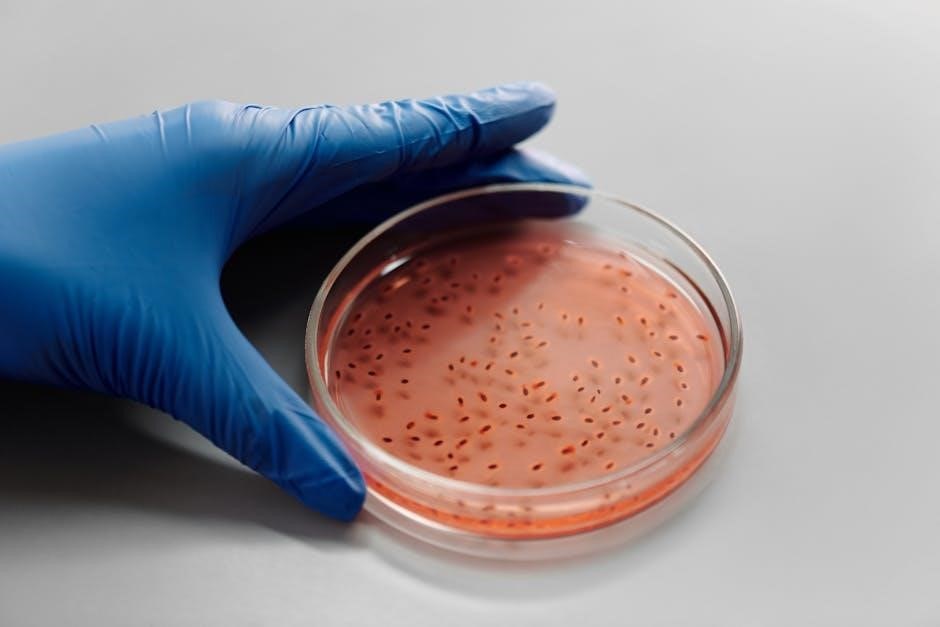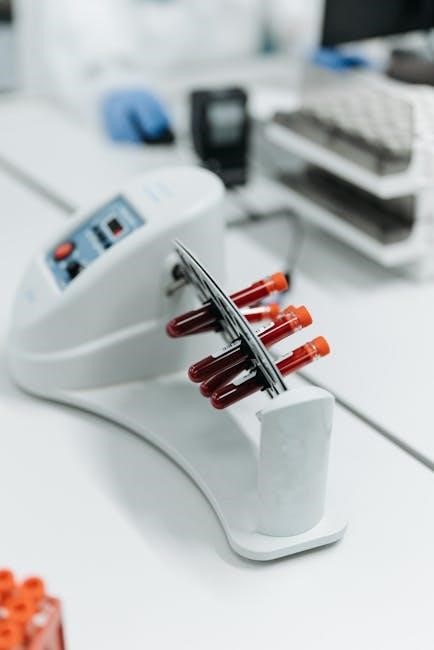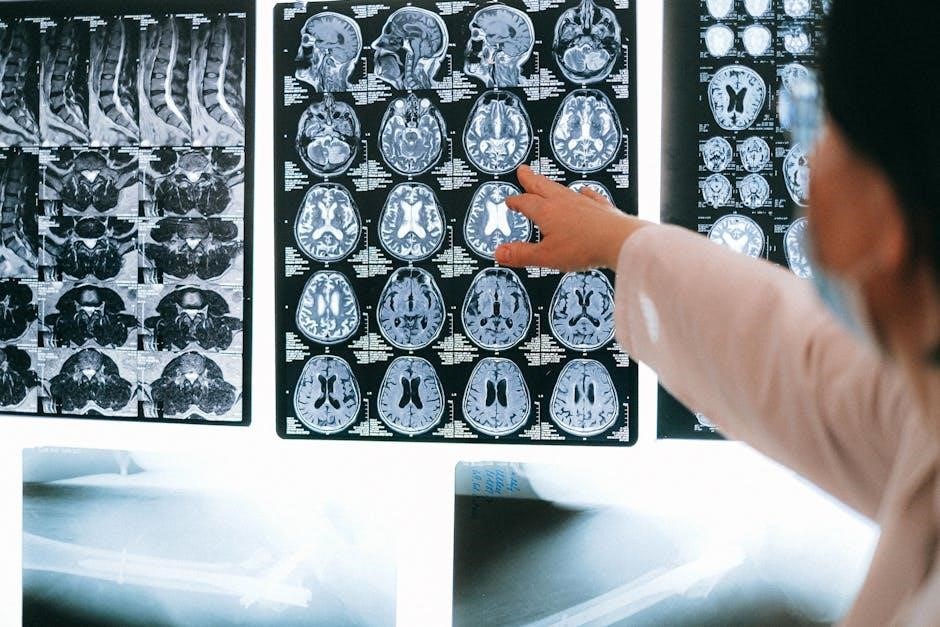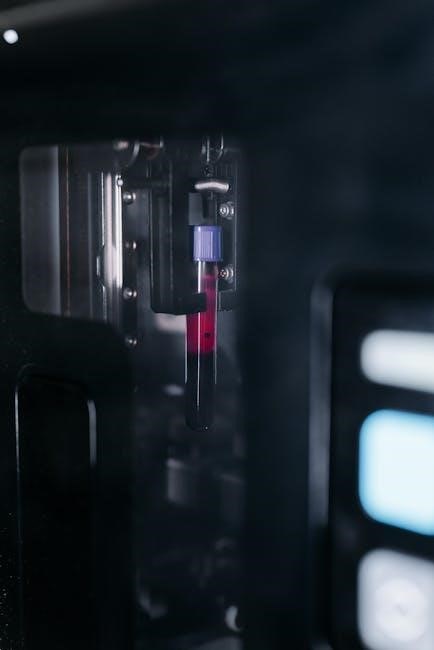Hypertension is a major global health issue, affecting millions worldwide. It is characterized by elevated blood pressure levels, leading to cardiovascular, renal, and cerebral complications if untreated. Primary and secondary forms exist, with the latter linked to identifiable causes. Early detection and management are crucial to prevent long-term organ damage and improve patient outcomes;
1.1 Definition and Classification
Hypertension is defined as a systolic blood pressure (SBP) ≥140 mmHg or diastolic blood pressure (DBP) ≥90 mmHg. It is classified into categories: normal (SBP <120 mmHg, DBP <80 mmHg), elevated (SBP 120-129 mmHg, DBP <80 mmHg), stage 1 hypertension (SBP 130-139 mmHg or DBP 80-89 mmHg), and stage 2 hypertension (SBP ≥140 mmHg or DBP ≥90 mmHg). Accurate classification is essential for guiding diagnosis, treatment, and prognosis, as outlined in the 2017 ACC/AHA guideline.
1.2 Epidemiology and Global Impact
Hypertension is a leading global health burden, affecting over a billion individuals worldwide. It is the primary cause of cardiovascular diseases, strokes, and kidney disease, contributing significantly to morbidity and mortality. Low- and middle-income countries face the highest prevalence due to limited healthcare resources and lifestyle factors. The economic impact is substantial, with costs attributed to medical care and lost productivity. Addressing hypertension requires comprehensive public health strategies to improve awareness, prevention, and management on a global scale.

Pathophysiology of Hypertension
Hypertension involves complex mechanisms like the renin-angiotensin-aldosterone system, endothelial dysfunction, and genetic predisposition, leading to increased vascular resistance and neurogenic influences that elevate blood pressure.
2.1 Renal Mechanisms in Blood Pressure Regulation
The kidneys play a central role in blood pressure regulation through mechanisms like the renin-angiotensin-aldosterone system (RAAS) and electrolyte balance. Renal pressure natriuresis ensures sodium and water excretion adjusts to blood pressure levels. Dysregulation can lead to hypertension.
2.2 Role of the Renin-Angiotensin-Aldosterone System (RAAS)
The RAAS is a critical regulator of blood pressure. Renin release by the kidneys triggers a cascade converting angiotensinogen to angiotensin II, a potent vasoconstrictor. Aldosterone, stimulated by angiotensin II, promotes sodium and water retention, increasing blood volume and pressure. Dysregulation of RAAS contributes significantly to hypertension, as excessive angiotensin II and aldosterone lead to vascular constriction and fluid retention, exacerbating cardiovascular stress and organ damage over time.
2.3 Neurogenic Factors and the Autonomic Nervous System
Neurogenic factors, particularly the autonomic nervous system (ANS), play a significant role in hypertension. The sympathetic nervous system (SNS) increases heart rate, vascular resistance, and renal sodium retention, elevating blood pressure. Chronic SNS activation contributes to vascular remodeling and kidney dysfunction, exacerbating hypertension. The parasympathetic nervous system (PNS) counteracts these effects by promoting vasodilation and relaxation. Imbalances between SNS and PNS activity, often due to stress or genetic predisposition, are key contributors to the development and progression of high blood pressure, highlighting the complex interplay of neural mechanisms in hypertension.
2.4 Vascular Alterations and Endothelial Dysfunction
Vascular alterations and endothelial dysfunction are central to hypertension pathophysiology. The endothelium regulates vasodilation and vasoconstriction, but its dysfunction reduces nitric oxide (NO) production, impairing blood vessel relaxation. Increased levels of endothelin-1 (ET-1), a potent vasoconstrictor, further exacerbate vascular tension. Structural changes, such as arterial stiffening and remodeling, increase peripheral resistance. These alterations lead to elevated blood pressure and contribute to target organ damage, highlighting the critical role of vascular and endothelial abnormalities in the progression of hypertension.

Primary (Essential) Hypertension
Primary hypertension is the most common form, arising from a combination of genetic, environmental, and lifestyle factors. It develops gradually without an identifiable cause.
3.1 Genetic Predisposition
Genetic factors significantly contribute to the development of primary hypertension. Specific genes, such as AGT, ACE, and NOS3, influence blood pressure regulation. These genes affect the renin-angiotensin-aldosterone system and endothelial function, increasing susceptibility. Family history and ethnic background also play roles, as certain populations exhibit higher prevalence rates. Genetic predisposition interacts with environmental factors, such as diet and lifestyle, to exacerbate blood pressure elevation. Understanding these genetic mechanisms aids in early identification and personalized treatment strategies for individuals at risk.
3.2 Environmental and Lifestyle Factors
Environmental and lifestyle factors play a critical role in the development of primary hypertension. Poor diet, obesity, physical inactivity, and excessive alcohol consumption are major contributors. High sodium intake disrupts renal sodium handling, while low potassium intake exacerbates blood pressure elevation. Stress and sleep deprivation further dysregulate the autonomic nervous system, increasing vascular resistance. Smoking and environmental toxins also impair endothelial function, promoting vascular stiffness. Addressing these modifiable factors is essential for hypertension prevention and management, emphasizing the importance of lifestyle interventions in reducing cardiovascular risk.

Secondary Hypertension
Secondary hypertension arises from identifiable causes like renal artery stenosis, pheochromocytoma, or adrenal disorders. Addressing the underlying condition can often cure this form of hypertension.
4.1 Causes and Underlying Conditions
Secondary hypertension is caused by identifiable factors such as renal artery stenosis, pheochromocytoma, or adrenal disorders. Conditions like hyperaldosteronism and Cushing’s syndrome also contribute. These underlying causes often lead to increased blood pressure due to hormonal imbalances or kidney dysfunction. Early identification and treatment of these conditions can effectively manage or cure secondary hypertension, emphasizing the importance of comprehensive diagnostic evaluation in such cases.
4.2 Diagnosis and Evaluation
Diagnosis of secondary hypertension involves a comprehensive workup to identify underlying causes. This includes laboratory tests such as plasma renin activity, aldosterone levels, and urinary metanephrines. Imaging studies like renal Doppler ultrasound or CT angiography are used to detect conditions like renal artery stenosis. A thorough medical history and physical examination are essential to guide further investigations. The goal is to confirm the presence of secondary hypertension and pinpoint the specific cause, enabling targeted treatment strategies.

Clinical Features and Presentation
Hypertension often presents asymptomatic but can cause headaches, dizziness, or visual disturbances in severe cases. Physical examination may reveal retinal changes, with blood pressure readings confirming the diagnosis.
5.1 Symptoms and Physical Examination Findings
Hypertension is often asymptomatic but may present with headaches, dizziness, or visual disturbances in severe cases. Physical examination findings include elevated blood pressure readings, retinal changes such as arteriolar narrowing or hemorrhages, and signs of target organ damage. Auscultation may reveal heart murmurs or crackles in the lungs, while peripheral edema can indicate fluid retention. These findings help guide further diagnostic evaluation and management strategies tailored to the patient’s condition.
5.2 Target Organ Damage
Chronic hypertension leads to damage in critical organs, including the heart, kidneys, brain, and eyes. Cardiac complications encompass left ventricular hypertrophy and heart failure. Renal damage manifests as chronic kidney disease or end-stage renal failure. Cerebral involvement includes stroke and cognitive decline. Ocular effects range from hypertensive retinopathy to vision-threatening hemorrhages. Early detection of these changes is vital to implement timely interventions and prevent progression, emphasizing the importance of regular monitoring in hypertensive patients.

Diagnostic Criteria and Staging
Hypertension is diagnosed using systolic and diastolic blood pressure thresholds, categorized into stages to guide management and prognosis, ensuring timely intervention for improved patient outcomes.
6.1 Blood Pressure Categories
Blood pressure categories are essential for diagnosing and managing hypertension. Normal blood pressure is below 120/80 mmHg, while prehypertension is 120-139/80-89 mmHg. Stage 1 hypertension is 140-159/90-99 mmHg, and Stage 2 is 160/100 mmHg or higher. These categories help guide treatment decisions and assess cardiovascular risk. Accurate measurement and classification are critical for early detection and intervention, ensuring personalized care and improved outcomes for patients with hypertension. Proper staging also aids in monitoring disease progression and response to therapy.
6.2 Laboratory and Imaging Studies
Laboratory and imaging studies are crucial for diagnosing and managing hypertension. Basic tests include complete blood count, serum creatinine, potassium, and lipid profiles to assess target organ damage; Urinalysis checks for proteinuria, indicating kidney involvement. Imaging studies like echocardiography and renal Doppler ultrasound help identify cardiac and renal abnormalities. These investigations guide treatment decisions, rule out secondary causes, and monitor disease progression. Regular monitoring ensures comprehensive care and early detection of complications, improving patient outcomes and reducing cardiovascular risk.

Complications of Hypertension
Hypertension leads to severe complications, including cardiovascular diseases, stroke, and renal failure. Chronic high blood pressure damages organs, increasing the risk of heart failure and vision loss.
7.1 Cardiovascular Complications
Hypertension significantly increases the risk of cardiovascular diseases. Chronic high blood pressure causes increased systemic vascular resistance, vascular stiffness, and endothelial dysfunction. This leads to conditions such as coronary artery disease, left ventricular hypertrophy, and heart failure. Additionally, hypertension is a major contributor to cerebrovascular events, including ischemic and hemorrhagic strokes. Over time, uncontrolled hypertension can also result in atherosclerosis, further exacerbating the burden on the cardiovascular system. These complications underscore the importance of early intervention and management to mitigate long-term cardiac and vascular damage.
7.2 Renal and Cerebral Implications
Hypertension significantly impacts renal and cerebral health. Chronic high blood pressure damages renal blood vessels, leading to conditions like hypertensive nephropathy and chronic kidney disease. Prolonged uncontrolled hypertension can result in albuminuria and progressive renal failure. Cerebrally, hypertension increases the risk of cognitive decline, silent brain infarcts, and white matter lesions. It also heightens the likelihood of stroke, both ischemic and hemorrhagic, due to weakened blood vessel walls. These complications highlight the critical need for stringent blood pressure control to preserve renal and cerebral function.

Management and Treatment Strategies
Management involves lifestyle changes, such as diet and exercise, alongside pharmacological interventions like ACE inhibitors and ARBs. Resistant cases require tailored approaches to achieve blood pressure control.
8.1 Lifestyle Modifications
Lifestyle changes are the first line of treatment for hypertension. These include adopting the DASH diet, reducing sodium intake, losing weight, and limiting alcohol consumption. Regular physical activity, such as aerobic exercises, is recommended to lower blood pressure. Quitting smoking and managing stress through techniques like meditation or yoga also contribute to blood pressure control. These modifications are often combined with pharmacological treatments to enhance effectiveness and reduce the risk of complications. Consistency and patient adherence are key to achieving long-term benefits.
8.2 Pharmacological Interventions
Pharmacological treatments for hypertension target specific pathways to lower blood pressure. Commonly used drugs include diuretics, ACE inhibitors, ARBs, calcium channel blockers, and beta-blockers. These medications reduce fluid retention, relax blood vessels, or decrease cardiac workload. Combination therapies are often employed for enhanced efficacy. Regular monitoring ensures optimal dosing and minimizes side effects. Pharmacological interventions are tailored to individual patient profiles, such as comorbidities like diabetes or kidney disease, to maximize benefits and reduce cardiovascular risks. Adherence to prescribed regimens is crucial for effective blood pressure control.
8.3 Resistant and Refractory Hypertension
Resistant hypertension refers to blood pressure remaining above target levels despite adherence to three antihypertensive medications, including a diuretic. Refractory hypertension is more severe, with uncontrolled blood pressure despite four or more medications. Evaluation involves identifying secondary causes, such as renal artery stenosis or aldosteronism. Management may include intensifying therapy, adding novel agents, or procedural interventions like renal denervation. These cases require a tailored approach to address underlying mechanisms and improve outcomes in challenging patient populations.

Special Populations
Hypertension management varies across special populations, including pregnant women, children, and the elderly. Each group requires tailored diagnostic and therapeutic approaches to address unique challenges.
9.1 Hypertension in Pregnancy
Hypertension during pregnancy is a significant condition that can lead to complications for both mother and fetus. It is classified into gestational hypertension and preeclampsia. Gestational hypertension occurs after 20 weeks of gestation without proteinuria, while preeclampsia involves high blood pressure with signs of organ dysfunction, such as protein in the urine. Risk factors include a history of hypertension, obesity, and multiple pregnancies. Early detection and monitoring are essential to prevent complications like preterm birth and maternal organ damage. Management strategies include lifestyle modifications and, in severe cases, antihypertensive medications and delivery.
9.2 Hypertension in Pediatric and Geriatric Patients
Hypertension in pediatric patients is often secondary, linked to renal or cardiac issues, while in geriatric populations, it is primarily due to vascular stiffness. Both groups require tailored approaches. Early diagnosis and management are crucial to prevent long-term complications. Geriatric patients often face comorbidities, necessitating careful medication adjustment. Pediatric cases may involve growth monitoring and lifestyle interventions. Regular blood pressure screening is vital for both groups to ensure timely intervention and improved outcomes.

Emerging Trends and Research
Recent advances focus on genetic predispositions and immune mechanisms in hypertension. Novel therapeutic approaches, including targeted therapies, are being explored to improve treatment efficacy and patient outcomes.
10.1 Advances in Pathophysiological Understanding
Recent research has deepened our understanding of hypertension’s pathophysiology, highlighting the interplay of genetic, environmental, and immune factors; Studies reveal that endothelial dysfunction and renal mechanisms play pivotal roles. The renin-angiotensin-aldosterone system remains central, but new insights into autonomic nervous system dysregulation and vascular stiffness have emerged. These findings are reshaping how hypertension is viewed, offering potential targets for intervention. Advances in molecular biology and imaging techniques further elucidate the complex mechanisms driving blood pressure elevation, paving the way for personalized treatment approaches. Ongoing investigations continue to uncover novel pathways, enhancing therapeutic possibilities.
10.2 Novel Therapeutic Approaches
Emerging treatments for hypertension focus on targeting specific pathophysiological pathways. Novel therapies include mineralocorticoid receptor antagonists and endothelin receptor blockers, offering improved efficacy in resistant cases. Immunomodulatory drugs are being explored to address immune-mediated hypertension. Advances in gene therapy and stem cell research aim to repair vascular dysfunction. Digital health tools and personalized medicine approaches are also gaining traction, enabling tailored treatment plans. These innovations hold promise for better disease management and improved patient outcomes in the future.
Hypertension remains a leading global health burden, necessitating comprehensive management strategies. Future research should focus on elucidating complex pathophysiological mechanisms and developing personalized therapies. Advances in precision medicine, gene therapy, and digital health tools promise improved outcomes. Public health initiatives aimed at lifestyle modification and early detection are critical. Collaborative efforts between clinicians, researchers, and policymakers are essential to reduce the global impact of hypertension and enhance therapeutic options for resistant and refractory cases.

